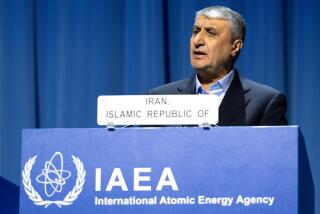Proliferation’s Dangerous Course : If Small-to-Middling Have Bomb, Will They Pull the Trigger?
- Share via
People who are genuinely concerned about the dangers of nuclear war should worry less about what is happening in Washington and Moscow these days and more about some of the items tucked away in the back pages of newspapers.
The head of Pakistan’s atomic-energy program is quoted as saying that his country now possesses the nuclear bomb. The statement has since been denied, but the United States may soon face the unhappy choice of cutting off arms aid to Pakistan, despite its important role as a sanctuary for anti-Soviet Afghan guerrillas, or allowing the Pakistanis to make a mockery of U.S. efforts to prevent the spread of nuclear weapons.
South Africa prepares to build a mile-long runway on an island in the Indian Ocean amid rumors that Israel and the Pretoria government are cranking up to conduct nuclear-weapons tests there. Brazilian newspapers report the existence of a nuclear-test site in the Amazon jungle. There is no confirmation.
Sober people in the national-security business have long felt that the greatest danger of nuclear war flows not from the prospect of a surprise missile attack by one great power on the other but from the chance of nuclear conflict between two small-to-middling countries whose alliance relationships might drag in America and the Soviet Union.
That was the reasoning behind the 1970 nuclear non-proliferation treaty, which sought to restrict membership in the nuclear-weapons club to the five nations already having nuclear arsenals. It was also the rationale behind bipartisan U.S. efforts in the 1970s to shape global nuclear-power development programs in ways that would not depend on nuclear fuels that could easily be diverted into nuclear weapons.
Strictly speaking, all this has paid off. No country has overtly joined the select circle of nuclear-armed nations since the treaty was signed. But Israel, which didn’t sign the treaty anyway, is presumed to have nuclear-weapons components on the shelf that could be assembled in short order. It has also deployed a nuclear-capable missile. India, another non-signatory, exploded a nuclear device in 1974, and presumably has the ability to build a nuclear arsenal.So far it apparently has not done so.
The danger of nuclear-weapons proliferation is moving into a new and more acute stage, however. Nuclear explosives can be made from plutonium or highly enriched uranium. Tight controls are supposedly in force to prevent the diversion of plutonium to the manufacturing of weapons. But 9,000 pounds of plutonium already are missing from the books in the United States alone; most of it was presumably “lost” through accounting errors or the manufacturing process--but the uncertainty on this point is troubling, given the outlook for growing quantities of plutonium worldwide.
Bennett Ramberg of UCLA’s Center for International and Strategic Affairs reports that by the end of the 1990s, 350 to 400 tons of plutonium will have been separated, supposedly for re-use in reactors. The more of the stuff that moves in world commerce, the greater the danger of diversion. Meanwhile, the list of countries said to be developing their own facilities for producing nuclear materials is growing.
Rex Nazare, head of Brazil’s nuclear-energy program, said recently that his country had already reprocessed uranium on a laboratory scale and was working to master all the processes required for turning uranium ore into reactor-fuel elements. Fortunately, Brazil’s aims seem peaceful--at least for the present.
South Africa has been thought to possess a standby nuclear-weapons capability since 1980 or 1981. Considering the violence and political instability that already plague the African continent, a decision by the South Africans to go defiantly public with their nuclear-weapons program would be unhelpful, to say the least.
Libya’s Moammar Kadafi has tried without success to buy a nuclear weapon. According to Leonard Spector of the Carnegie Endowment for International Peace, the Shah of Iran initiated a nuclear-weapons research program in the late ‘70s. The program presumably fell into the hands of the Khomeini regime along with a U.S.-supplied research reactor.
The most immediately dangerous situation of all, however, involves India and Pakistan. Spector, who addressed the California Seminar on International Security a few days ago, sees growing evidence that Pakistan has indeed developed the ability to fabricate all the necessary components for nuclear arms. India threatens to take “appropriate action” if Pakistan, its arch-enemy, proceeds with a weapons program.
Considering U.S. commitments to Pakistan’s security and the Soviet Union’s close ties to India, the prospect of the old adversaries facing each other with nuclear weapons on each side is nightmarish.
President Reagan is currently seeking a six-year, $4-billion Pakistani aid package from Congress. But he is required to certify that Pakistan has no nuclear device; that, under present circumstances, is increasingly hard to do with a straight face.
Recently the U.S. ambassador warned the Pakistani government that proceeding with a nuclear test could compel a cutoff in aid. Congressional critics, led by Sen. John Glenn (D-Ohio), accuse the Administration of being too soft on Pakistan because that country is the main channel for aid to the Afghan rebels. Glenn wants to cut off aid until there is credible evidence that the Pakistani nuclear-weapons program has been put onto the shelf.
Maybe such threats will be sufficient. After all, President Zia ul-Haq needs continued U.S. aid and support, and should be reluctant to risk losing it. But what if he defies Washington anyway? Are Congress and the President really willing to risk an anti-American outburst that could trigger the effective collapse of the Afghan resistance movement and endanger Western security interests in the area?
If the Pakistanis hang tough, Washington faces a painful choice indeed.
More to Read
Sign up for Essential California
The most important California stories and recommendations in your inbox every morning.
You may occasionally receive promotional content from the Los Angeles Times.










